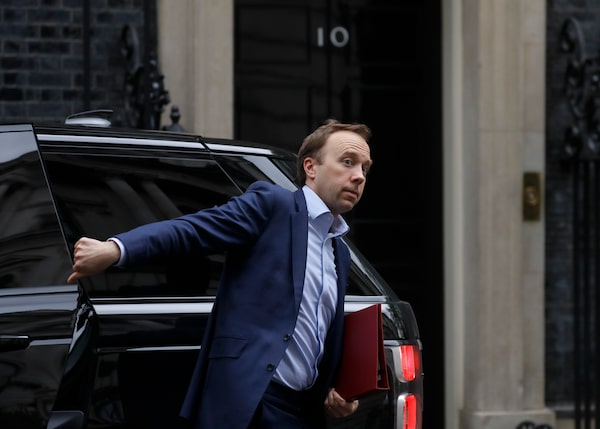
Britain's Health Secretary Matt Hancock arrives in Downing Street in London on April 29, 2020.Kirsty Wigglesworth/The Associated Press
Britain’s pandemic lockdown was supposed to be almost completely eased this coming weekend, with pubs, restaurants, movie theatres and other venues opening for the first time in more than three months. But a spike of COVID-19 cases in Leicester has forced officials to postpone reopenings in that city and raised questions about whether the government is moving too fast.
British Prime Minister Boris Johnson has been keen to move the country away from battling the pandemic and toward restarting the economy, which has been crippled by the outbreak. He announced last week that nearly all of the lockdown restrictions will be removed on Saturday. And Mr. Johnson will set out on Tuesday his plan to spend the economy out of its crisis, with a speech promising to fast-track £5-billion ($8.4-billion) of infrastructure investment in hospitals, schools, roads and other projects.
The sudden surge of confirmed cases in Leicester has put the government’s reopening strategy to an early test and it has illustrated the challenges Mr. Johnson and other world leaders face in balancing economic needs against public-health realities.
British health officials have been worried for several days about the rising number of cases in the East Midland’s city, which has a population of around 340,000. Figures compiled by Public Health England showed that Leicester has had 2,987 COVID-19 cases in total since March, with 866, or 29 per cent, occurring in the last 10 days. Those figures prompted public-health officers to increase testing in the city last week with four mobile screening units focused on people who do not show any symptoms.
On Monday, Health Secretary Matt Hancock told the House of Commons that in recent days the infection rate in Leicester had been three times higher than the next highest city. Mr. Hancock announced that there will be no easing of lockdown measures in Leicester as well as several surrounding communities on Saturday. And he said stores that had been allowed to open will have to close along with schools that had also reopened. The government will review these actions in two weeks, he said.
It’s not clear why the infections have spiked in the municipality. Leicester’s public-health director, Ivan Browne, said most of the new cases have been centred in the eastern part of the city and involved largely the younger working-age population. “I don’t think at the moment we’re seeing a single cause or a single smoking gun on this; so we need really try to dig down and find out what is going on, and it’s likely to be a combination of factors,” Dr. Browne told the BBC.
When can I go back to the gym? A guide to Canada’s reopening and COVID-19
COVID-19 news: Updates and essential resources about pandemic
Leicester’s mayor, Sir Peter Soulsby, expressed frustration at the actions of the government and questioned the need for an extended lockdown. “The level of the outbreak of the disease is declining in Leicester in precisely the same way it is declining elsewhere in England,” he told reporters. “We’ve had more testing in Leicester and it is largely the result of that more testing that we are getting more positive cases. … If there is a case for continuing the restrictions in Leicester, why is there not a similar case for continuing them in the rest of England?”
The pandemic is far from over in Britain and the country still records almost 1,000 new cases of the virus every day. In total, more than 311,000 people have been infected since March and 43,575 have died, the highest death toll in Europe. While the number of cases and hospital admissions has been growing at a much slower pace across much of the country in recent weeks, there have been a troubling number of hot spots. Along with Leicester, other cities such as Manchester, Liverpool and Doncaster have also seen a large volume of cases in recent weeks.
Mr. Johnson said on Monday that he was concerned about the situation in Leicester and the government was prepared to impose more local lockdowns if the outbreak surges. “I want to stress to people that we are not out of the woods yet,” he said. The Prime Minister added that the government’s “whack-a-mole” strategy of tightening up restrictions temporarily had worked recently in other parts of the country where infections surged on a smaller scale, including in areas of London. “That’s the same approach that we will bring to bear in Leicester as well,” he added.
Experts said it will be critical to establish the boundaries of any regional lockdown to ensure that it’s effective. “One of the biggest problems is deciding who is in the lockdown area and who is not,” said Keith Neal, emeritus professor of the epidemiology of infectious diseases at the University of Nottingham. “This needs to be understandable to both the people who are inside and the people on the outside. People on the inside of the lockdown need to understand why they have been included.”
With a report from Reuters
Sign up for the Coronavirus Update newsletter to read the day’s essential coronavirus news, features and explainers written by Globe reporters.
 Paul Waldie
Paul Waldie